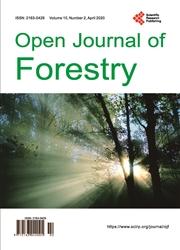The Social Dynamics of Illegal Wood Harvesting on Indigenous Woody Vegetation: A Case Study of Chimanimani National Park, Eastern Zimbabwe
引用次数: 2
Abstract
Illegal wood harvesting, a factor that threatens conservation efforts, was assessed in Chimanimani National Park (CNP), eastern Zimbabwe, in April 2016. The study identified preferred indigenous woody species, determined the uses and quantities of indigenous wood extracted, and established local people’s knowledge and perceptions on forest resource conservation, institutional framework and management by-laws. Mixed data collection methods, which included questionnaires and semi-structured interviews were used. For questionnaires, a three-stage sampling design was adopted; that is, purposive sampling, where three Wards (i.e. Chikukwa Ward 11, Chikwakwa Ward 17 and Ngorima Ward 5b) were selected as study areas from a total of seventeen Wards in Chimanimani District. The three selected Wards had a combined total of 15 villages. Stage 2 involved random sampling, where three villages, one from each selected Ward, i.e. Batanai (75 households), Chikukwa (110 households) and Tamuka (46 households), with a total of 231 households, were chosen. Stage 3 was the random selection of households, where 46 questionnaires were administered and collected in the 3 selected villages, representing 20% of the targeted population. The study results highlighted that the preferred woody species included those of Acacia, Bauhinia, Brachystegia, Combretum, Pericopsis and Terminalia genera. The illegally harvested indigenous woody plants were principally for household uses. Quantities collected ranged from 0.2 to 0.4 tons for firewood monthly and 3 to 6 tons mostly for tobacco curing. Most respondents reported that by-laws were not effective in combating illegal wood harvesting. It was concluded that CNP woodlands are under pressure due to illegal wood harvesting. It is recommended that a robust community-based strategy to conserve woody species and natural resource utilisation be developed.在当地木本植被上非法采伐木材的社会动态——以津巴布韦东部奇马尼马尼国家公园为例
2016年4月,津巴布韦东部奇马尼马尼国家公园(CNP)对非法砍伐木材这一威胁保护工作的因素进行了评估。该研究确定了首选的土著木本物种,确定了提取的土著木材的用途和数量,并确立了当地人民对森林资源保护、体制框架和法律管理的知识和看法。采用了包括问卷调查和半结构化访谈在内的混合数据收集方法。调查问卷采用三阶段抽样设计;即有目的的采样,从Chimanmani区总共17个病房中选择三个病房(即Chikukwa病房11、Chikwakwa病房17和Ngorima病房5b)作为研究区域。选定的三个行政区共有15个村庄。第二阶段涉及随机抽样,从每个选定的选区中选择三个村庄,即Batanai(75户)、Chikukwa(110户)和Tamuka(46户),共231户。第三阶段是随机选择家庭,在选定的3个村庄中进行了46次问卷调查,占目标人口的20%。研究结果强调,首选的木本物种包括Acacia属、Bauhinia属、Brachystegia属、Combretum属、Pericopsis属和Terminalia属。非法采伐的本土木本植物主要用于家庭用途。每月收集的木柴数量从0.2吨到0.4吨不等,主要用于腌制烟草的数量从3吨到6吨不等。大多数答复者报告说,在打击非法采伐木材方面,附例并不有效。得出的结论是,由于非法采伐木材,CNP林地面临压力。建议制定一项强有力的基于社区的战略,以保护木本物种和自然资源的利用。
本文章由计算机程序翻译,如有差异,请以英文原文为准。
求助全文
约1分钟内获得全文
求助全文

 求助内容:
求助内容: 应助结果提醒方式:
应助结果提醒方式:


